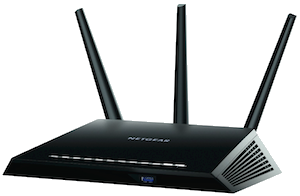 Works great. Looks UGLY!Last week I did something very uncharacteristic for a self-professed, died-in-the-wool, drank the KoolAid, Apple fanboy. I replaced my four year old Airport Extreme (Wireless-N) router with a new Netgear AC1900. Why would I commit such a traitorous act? Well, I guess my gearhead left brain overpowered my Apple-nirvana right brain. Also, I’ve been wanting to upgrade to wireless-AC since I bought my new MacBook Pro a few months back and I learned that Apple stopped supporting SNMP on their newest wireless-AC capable AirPort Extreme. In my world of limited bandwidth, SNMP is a feature I don’t want to live without. Additionally, I’ve been dying to install and run DD-WRT, the open-source router firmware that gives sub-$200 routers the power of Cisco devices costing ten times more. DD-WRT firmware is a lean Linux kernel that supports all typical router functions plus has features for VPN (Virtual Private Networking), QoS (Quality of Service like bandwidth shaping and prioritization), NAS (Network Attached Storage) and a host of features for network traffic monitoring, graphing and logging. In practical terms, it gives me the ability to keep my daughter’s Hulu habit from hogging all our Internet bandwidth, lets me log into my home network from anywhere and the router also serves as a handy, “always on” secure file server that our Macs, iOS devices and (cough) Windows machines can all access.
Works great. Looks UGLY!Last week I did something very uncharacteristic for a self-professed, died-in-the-wool, drank the KoolAid, Apple fanboy. I replaced my four year old Airport Extreme (Wireless-N) router with a new Netgear AC1900. Why would I commit such a traitorous act? Well, I guess my gearhead left brain overpowered my Apple-nirvana right brain. Also, I’ve been wanting to upgrade to wireless-AC since I bought my new MacBook Pro a few months back and I learned that Apple stopped supporting SNMP on their newest wireless-AC capable AirPort Extreme. In my world of limited bandwidth, SNMP is a feature I don’t want to live without. Additionally, I’ve been dying to install and run DD-WRT, the open-source router firmware that gives sub-$200 routers the power of Cisco devices costing ten times more. DD-WRT firmware is a lean Linux kernel that supports all typical router functions plus has features for VPN (Virtual Private Networking), QoS (Quality of Service like bandwidth shaping and prioritization), NAS (Network Attached Storage) and a host of features for network traffic monitoring, graphing and logging. In practical terms, it gives me the ability to keep my daughter’s Hulu habit from hogging all our Internet bandwidth, lets me log into my home network from anywhere and the router also serves as a handy, “always on” secure file server that our Macs, iOS devices and (cough) Windows machines can all access.
I did my homework before purchasing the AC1900. I read enough router reviews and comparison pieces to suit me for two lifetimes. I wanted a wireless AC device with top-notch hardware specs of course, but equally important: I wanted a router proven to easily convert to and work well with the latest version of DD-WRT firmware. Now, I’m not here to write a “router rundown”. Believe me, there’s more than enough of those floating around on the net. One site I found particularly useful is flashrouters.com. It flushes out several routers spanning a wide economic spectrum pointing out the features of each in a clear, concise manner. Every router specified on the site is proven 100% compatible with DD-WRT and they rated the Netgear Nighthawk the best for 2014. I chose the AC1900 because I wanted a popular router from a name brand company with lots of horsepower, high-end hardware features and support for the latest wireless standards.
So…Netgear? Check.
Dual-core 1 GHz. processor, 256 MB RAM, USB 3 and 5 port gigabit switch? Check.
Dual band Wireless-AC up to 1900 Mb/sec. with three antennas? Check and Check!.
Add to this list the fact that the AC1900 works so well with the DD-WRT firmware, Netgear advertises that piece of information on their web site. When I bought the router in August it was by far the best hardware available for DD-WRT. I think it has since been supplanted, but the AC1900 has been around just long enough for there to be a substantial knowledge base around using it with DD-WRT. Let’s face it, replacing a router’s operating system via the “nuke & pave” method isn’t something one does on a lark. I’m the kind of person who likes to know several others have done this successfully, lest I brick a brand new $200 router. Call me timid.
Well, it turns out I made a good choice. The router works great and the installation of DD-WRT could not have been easier. I simply replaced my AirPort Extreme with the Netgear box, downloaded what I determined to be a very stable and functional DD-WRT build for the AC1900 from myopenrouter.com and used the built-in update function of the router to flash the new operating system. I’m not going to go into the details here (one of the Web sites linked to in this article provide all the step-by-step instructions you need), but the entire process was so simple the whole effort took less than 30 minutes. After that, it was simply a matter of setting the admin password and setting up the ports I needed to forward. DD-WRT’s web interface is so simple and clean I managed to do everything I needed in just a few minutes without searching the web for help.
Now I have a router that’s much more capable than an AirPort Extreme and the wireless-AC is every bit as fast with a little better range. The hardest thing for me is not seeing the sleek, white antenna-less box with the Apple logo on top. Now my router looks like some futuristic battle tank from a cheap FPS! Oh well. Can’t have everything, I guess.
 Thursday, October 1, 2015 at 1:45PM
Thursday, October 1, 2015 at 1:45PM 
 Verify in
Verify in  Tips & Tricks
Tips & Tricks 



